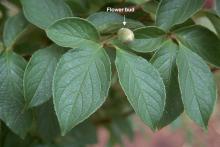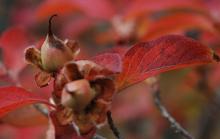Stewartia koreana
Common name:
Korean Stewartia
Pronunciation:
stu-AR-ti-a kor-e-A-na
Family:
Theaceae
Genus:
Synonyms:
Stewartia pseudocamellia var. koreana
Type:
Broadleaf
Native to (or naturalized in) Oregon:
No
- Broadleaf deciduous tree, may grow to 20-30 ft (6-9 m) tall, upright, dense, often multi-branched low; bark exfoliates in flakes, color varies from gray to orange and reddish browns. Leaves alternate, simple, elliptic, 2.5-10 cm long and 2-7.5 cm wide, abruptly pointed (acuminate), base wedge-shaped or rounded, remotely serrate, dark green and without hairs (glabrous) above, slightly pubescent below; fall color might include purple, red, orange and yellow, but reportedly some trees show little color. Flowers white, about 6-7.5 cm wide, 5-6 petals, large yellow center (yellow stamens), similar to S. pseudocamellia; but flatter rather than cup-shaped; blooms in early to mid-summer. Fruit brown, pointed, pyramidal capsule, about 4-5 cm long, splits to release seeds, persistent.
- Sun to part shade. Best in moist, acidic soil.
- Hardy to USDA Zone 5. Native to Korea; introduced in 1917 by E. H. Wilson.
- Taxonomy: Sometimes Stewartia koreana is listed as variety (var.) of S. pseudocamellia, hence Stewartia pseudocamellia var. koreana (World Flora Plant List), or Stewartia ptero-petiolata var. koreana (RHS Dictionary of Hort.), or Stewartia pseudocamellia 'Korean Splendor'. See Dirr (2009, p.1088) for his views on this.
- koreana: of Korea.








